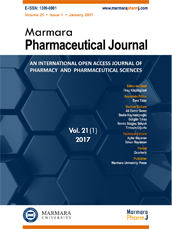Editor-in-Chief
Hatice Kübra Elçioğlu
Vice Editors
Levent Kabasakal
Esra Tatar
Online ISSN
2630-6344
Publisher
Marmara University
Frequency
Bimonthly (Six issues / year)
Abbreviation
J.Res.Pharm.
Former Name
Marmara Pharmaceutical Journal
Marmara Pharmaceutical Journal
2017 , Vol 21 , Issue 3
Application of electrospun nanofibers in drug delivery and tissue engineering
1Karadeniz Teknik Üniversitesi, Eczacılık Fakültesi, Farmasötik Teknoloji Anabilim Dalı, Trabzon 61080 Türkiye2Ankara Üniversitesi, Eczacılık Fakültesi, Farmasötik Teknoloji Anabilim Dalı, Tandoğan, Ankara 06100 Türkiye DOI : 10.12991/marupj.306787 Nanofibers which have a longer length than its diameter are widely used in many areas i.e. drug delivery systems and tissue engineering because of their convenient surface area to volume ratio. Electrospinning is the most common method for processing nanofibers. The nanofibers that are processed by electrospinning are called electrospun nanofibers. During the process, physicochemical properties of electrospun nanofibers can be affected by different parameters including applied voltage, solution flow rate, distance between capillary and collector, polymer physicochemical properties. Drug release properties of electrospun nanofibers are determined by diffusion and polymer degradation. Additionally, nanofibers" types i.e. matrix types or reservoir types affect drug release properties. Since the physical properties of nanofibers allow researchers to produce an artificial extracellular matrix to mimic microenvironments of tissues, they are used in tissue engineering for regeneration and production of a new tissue or an organ. Biosimilar nanofibers, therefore, can be obtained by modifying surfaces of nanofibers. Findings of our study suggest that because of their biosimilar character and providing intended drug release profile, nanofibers have a promising potential in the future of tissue engineering research. Keywords : biosimilar, tissue engineering, electrospinning, drug delivery systems, nanofiber

